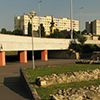Contrast as Aesthetic Value in the Townscape
Modernity and Preservation in the 1960s and 1970s in Hungary
DOI:
https://doi.org/10.18030/socio.hu.2020en.75Kulcsszavak:
architectural sociology, sociology of urban planning, sociology of monument preservation, cultural heritageAbsztrakt
The 1960s and 1970s represent a period of housing estate construction in Europe, and this urban architectural model greatly affected the former socialist countries, including Hungary. It seems logical therefore that monument and townscape protection could not find its place in that period of building boom. Nevertheless, Hungarian monument protection flowered in those decades. The reason for this was that the search for “contrast” was one of the leading paradigms in modern urban aesthetics, and this contrast also highlighted development: the remaining architectural monuments and urban zones as relics emphasized the different characteristics of the modern town as opposed to the old one. Thus, while urban architects were working on creating the “new townscape”, experts of monument protection had a wide range of license in their field to preserve the historical milieu as a contrast to the modern one. Naturally, this historical milieu had the stamp of the aesthetical paradigms of modern architecture as well. Therefore the old houses were interpreted as the antitype of modern design, the static and rationality were stressed, instead of the decoration and social representation of old structures. This paper attempts to verify empirically the above thesis by analyzing three Hungarian sites: the completely reconstructed Budapest-Óbuda, Komárom as municipal center and semi-new town in the 1960s and 1970s, and Esztergom as a historical town.






